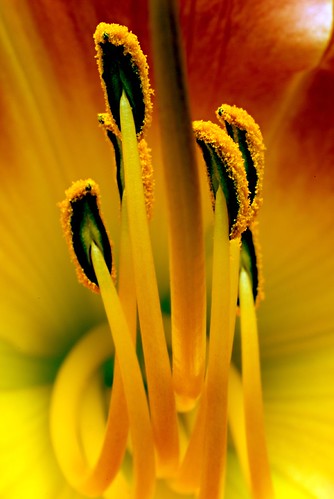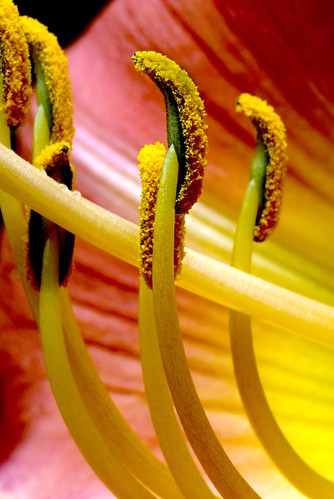OK, so I’ve “borrowed” Michael Pollan’s excellent title for this story. These photos are of day lilies. The subject is mostly the stamens, or male sexual organs, of each flower. The stamen consists of the anthers at the top of a delicate stalk, and the stalk itself, called a “filament.” The anthers host the pollen, used for fertilization.
Each flower has several stamen, but only one pistil (the female sexual organ). The stalk of the pistil, which you can see in these photos although it is not really the subject of the photos, is called a “style.” In these pictures, you can’t really see the “stigma” (at the top end of the style), or the ovary at the base of the pistil. We tend to think of the ovary in non-botannical terms as the flower’s “bud.”
In the photo above, stamen cluster around the single pistil (really, the style belonging to the pistil). You are looking down into the ovary. In contrast, in the photograph below, a group of stamen are standing upright, anthers waving in the breeze. The stamens are grouped around a single style, which is perpendicular to the stamens. The style is part of a pistil with stigma to the left (out of the photo), and comes out of an ovary to the right (also not visible).
View this photograph larger.
These day lilies grow along the little side path right outside our kitchen door. I photographed them sitting on the stone flagstones we’ve used to pave the area. I have a new macro lens, a Sigma f/2.8 50mm. This is a fairly inexpensive macro lens, and it seems pretty sharp. When I add an extension tube to it, and get real close to the subject (like I did with these photos, poking my lens right into the flower), I can get really crisp magnifications. These photos were routinely processed with no special gimmicks in Photoshop.
Of course, the photos are not about botany, the sexual parts of flowers, my kitchen path, or the lens I used. They are about color, lines, and grace.


Pingback: Photoblog 2.0: » Photoblog 2.0 Archive: » What is the question?
Pingback: Photoblog 2.0: » Photoblog 2.0 Archive: » Echinacea Harvest Moon
Pingback: Photoblog 2.0: » Photoblog 2.0 Archive: » Among the Anthers